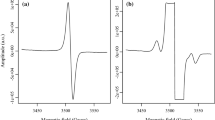Abstract
Identification of different irradiated foods containing cellulose, sugars, or bone is possible using electron spin resonance (ESR) spectroscopy. In the present study, ESR spectral characteristics of radiation-induced radicals in irradiated standard materials (cellulose, sugars, and hydroxyapatite) were compared using different ESR spectrometers, such as JES-300 (JEOL, Japan), Miniscope MS-400 (Magnettech, Germany), and e-scan™ Food analyzer (Bruker, USA). Upon irradiation (0–10 kGy), all standard materials showed typical radiation-specific ESR spectra. Instrumental variations in signal intensity, spectral shapes, and detection applicability were observed and should be taken into consideration from practical point of view.
Similar content being viewed by others
References
Arvanitoyannis IS (2010) Consumer behavior toward Irradiated food. In Irradiation of Food Commodities: Techniques, Applications, Detection, Legislation, Safety and Consumer Opinion, pp. 673–698. Academic Press Publications, UK.
Boshard JAP, Holmes DE, and Piette LH (1971) An inherent dosimeter for irradiated foods: papayas. Appl Radiat Isot 22, 316.
Chauhan SK, Kumar R, Nadanasabapathy S, and Bawa AS (2009) Detection methods for irradiated foods. Compr Rev Food Sci Food Saf 8, 4–16.
Delincée H (2002) Analytical methods to identify irradiated food-a review. Radiat Phys Chem 63, 455–458.
Douifi L, Raffi J, Stocker P, and Dole F (1998) A point about electron paramagnetic resonance detection of irradiated foodstuffs. Spec Acta A-MolBiomol Spec 54, 2403–2412.
EN 13708 (2001) Foodstuffs-detection of irradiated food containing crystalline sugar by ESR spectroscopy. European Committee of Standardization (CEN), Belgium.
EN 1786 (1996) Foodstuffs-detection of irradiated food containing bone by ESR Spectroscopy. European Committee of Standardization (CEN), Belgium.
EN 1787 (2000) Foodstuffs-Detection of irradiated food containing cellulose by ESR Spectroscopy. European Committee of Standardization (CEN), Belgium.
Esteves MP, Andrade ME, and Empis J (1999) Detection of prior irradiation of dried fruits by electron spin resonance (ESR). Radiat Phys Chem 55, 737–742.
Farkas J and Mohácsi-Farkas C (2011) History and future of food irradiation. Trends Food Sci Technol 22, 121–126.
Ghelawi MA, Moore JS, Bisby RH, and Dodd NJF (2001) Estimation of absorbed dose in irradiated dates (Phoenix dactylifera L.). Test of ESR response function by a weighted linear least-squares regression analysis. Radiat Phys Chem 60, 143–147.
Gordy W, Ard WB, and Shields H (1955) Microwave spectroscopy of biological substances. I. Paramagnetic resonance in X-Irradiated amino acids and proteins. Proc Natl Acad Sci USA 41, 983–984.
Jo D and Kwon JH (2006) Detection of radiation-induced markers from parts of irradiated kiwi fruits. Food Control 17, 617–621.
Malec-Czechowska K, Strzelczak G, Dancewicz AM, Stachowicz W, and Delincée H (2003) Detection of irradiation treatment in dried mushrooms by photostimulated luminescence, EPR spectroscopy and thermoluminescence measurements. Eur Food Res Technol 216, 57–65.
Ozsayin F and Polat M (2011) Irradiation detection of coffee mate by electron spin resonance (ESR). Radiat Phys Chem 80, 771–775.
Raffi J, Yordanov ND, Chabane S, Douifi L, Gancheva V, and Ivanova S (2000) Identification of irradiation treatment of aromatic herbs, spices and fruits by electron paramagnetic resonance and thermoluminescence. Spec Acta A-Mol Biomol Spec 56, 409–416.
Author information
Authors and Affiliations
Corresponding author
Rights and permissions
About this article
Cite this article
Lee, JH., Ahn, JJ., Akram, K. et al. Comparison of electron spin resonance (ESR) spectra of irradiated standard materials using different ESR spectrometers. J Korean Soc Appl Biol Chem 55, 407–411 (2012). https://doi.org/10.1007/s13765-012-1025-9
Received:
Accepted:
Published:
Issue Date:
DOI: https://doi.org/10.1007/s13765-012-1025-9




